
An attempt to install solar panels for solar power generation as a prop, etc. at a high position and farming in the space below them is agricultural solar power generation, and it can generate profits by combining power generation and agriculture. The experiment conducted by British and Italian research teams suggested the possibility of improving the agricultural efficiency of agricultural solar power generation by using colored translucent solar panels instead of ordinary solar panels.
It was in 1981 that agricultural solar power generation was proposed. However, in recent years, as solar power generation efficiency increases, economic pressures on small-scale farmers are increasing, which is drawing attention again. Agro-type solar power generation can secure the light necessary for crop growth by providing solar light to the lower space by arranging solar panels at appropriate intervals rather than arranging them.
The advantages of combining solar power generation and agriculture are not only that the two methods of power generation and agriculture will be profitable and economically stable. The fact that crops are protected from extreme wind and temperature changes by solar panels lined up on farmland, and that the water cooling effect on the crops alleviates overheating of solar panels is also considered as an advantage of agricultural solar power generation.
Meanwhile, the fact that the amount of light corresponding to the plant is absolutely reduced compared to general cultivation is a disadvantage of agricultural solar power generation because sunlight is blocked by solar panels. The yield of lettuce grown on solar panels is said to decrease by 15-30% compared to when grown under normal conditions.
A research team composed of British and Italian researchers worked on a method to improve the agricultural efficiency of agricultural solar power generation by controlling the wavelength of light transmitted through the solar panel. Plants use sunlight for photosynthesis, but not all wavelengths of light contained in sunlight are used for photosynthesis. Chlorophyll, the main photosynthetic pigment in plants, mainly absorbs red and blue wavelength light for photosynthesis, but does not absorb green wavelength light but reflects it.
Solar panels used for conventional agricultural solar power generation are translucent and absorb light uniformly to attenuate light hitting plants. The research team thought that it might improve the agricultural efficiency of agricultural solar power generation by coloring the translucent solar panel and adjusting the wavelength of light hitting the plants.
In fact, the research team can make a translucent solar panel that absorbs blue and green wavelengths preferentially and passes red wavelength light. In this special solar panel and clear glass panel, we created a farming solar power environment, actually cultivating basil and spinach and comparing their growth.
When special solar panels are installed, the amount of sun reaching the basil and spinach grown under them is expected to decrease by up to 57%, resulting in a sharp decline in yield. However, comparing the actual yield to that grown on a transparent glass panel, basil was reduced by only 15% and spinach by only 26%. Regarding this result, the research team explained that the reason for the increased photosynthetic efficiency through which the developed solar panel passed the red light used for photosynthesis.
Compared to general cultivation, the yield to enter the market is reduced, but agricultural solar power generation can also expect profits from power generation. The research team said that the experimental data show that farming solar power can bring about 2.5% increase in economic benefits of basil and 35% of spinach compared to conventional farming. Claimed that it could lead to. Related information can be found here .


















Add comment